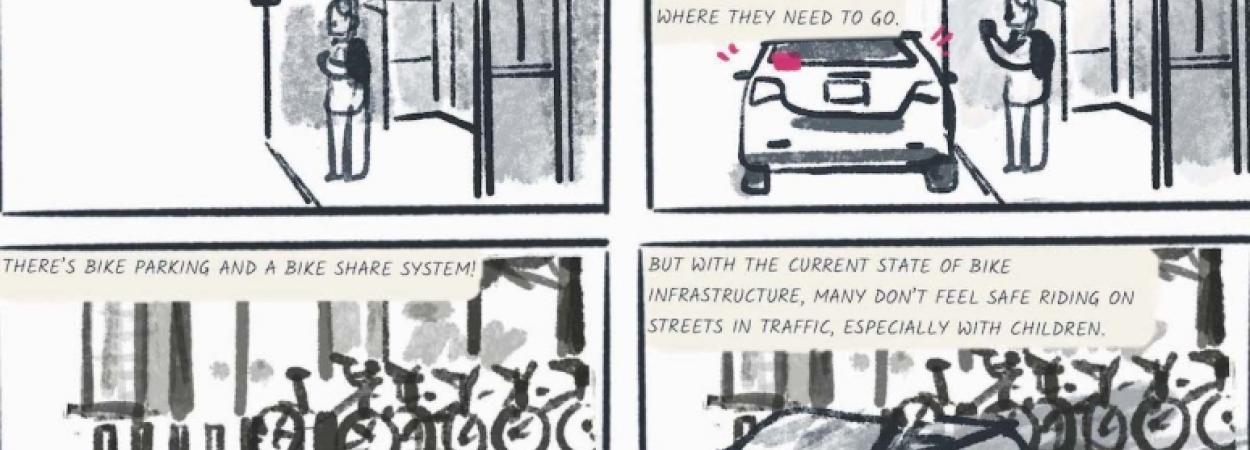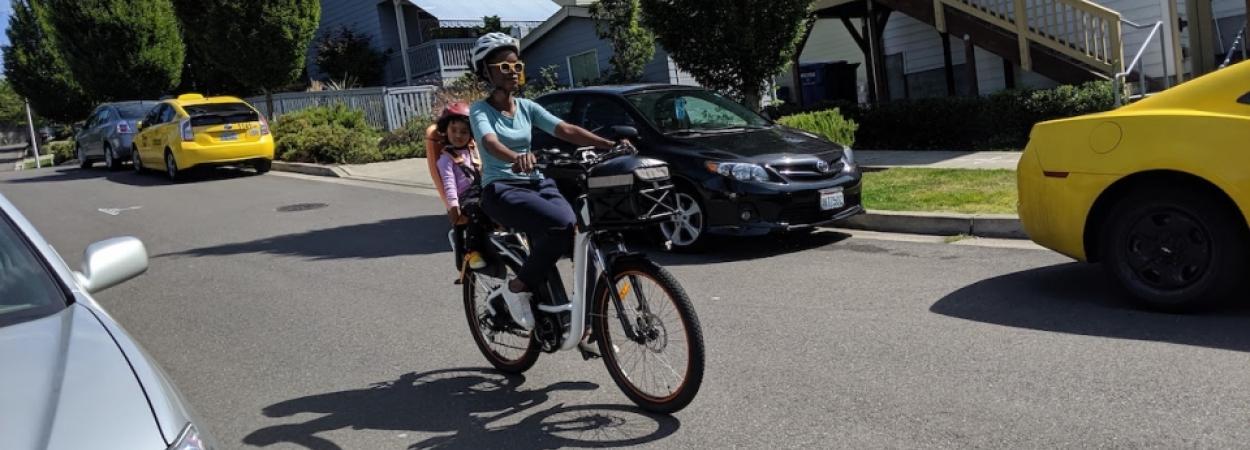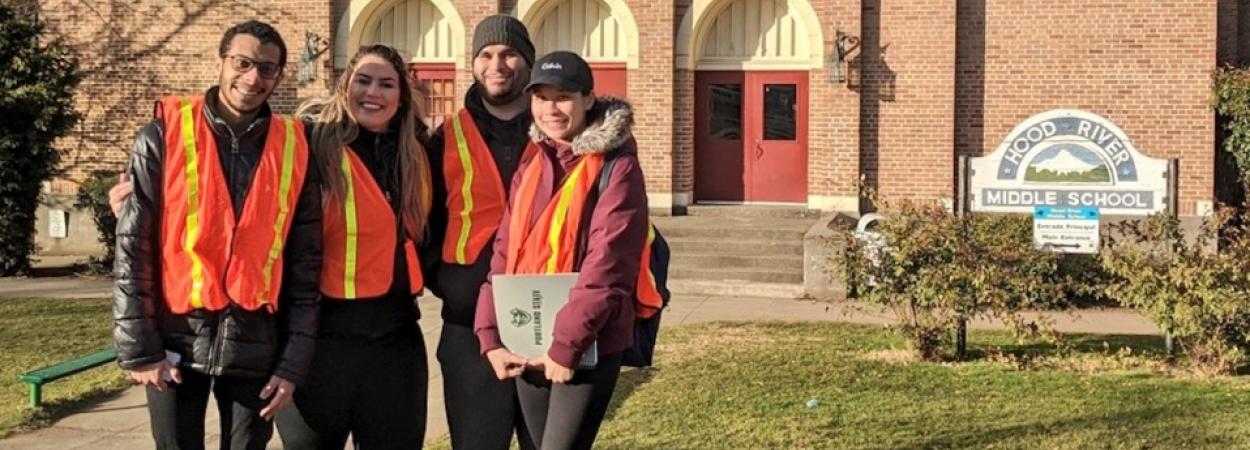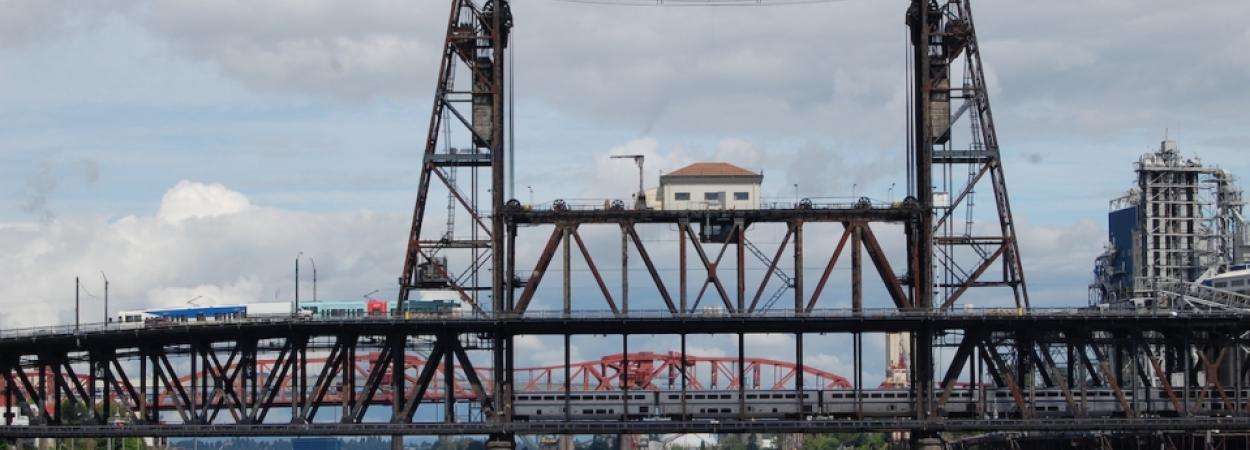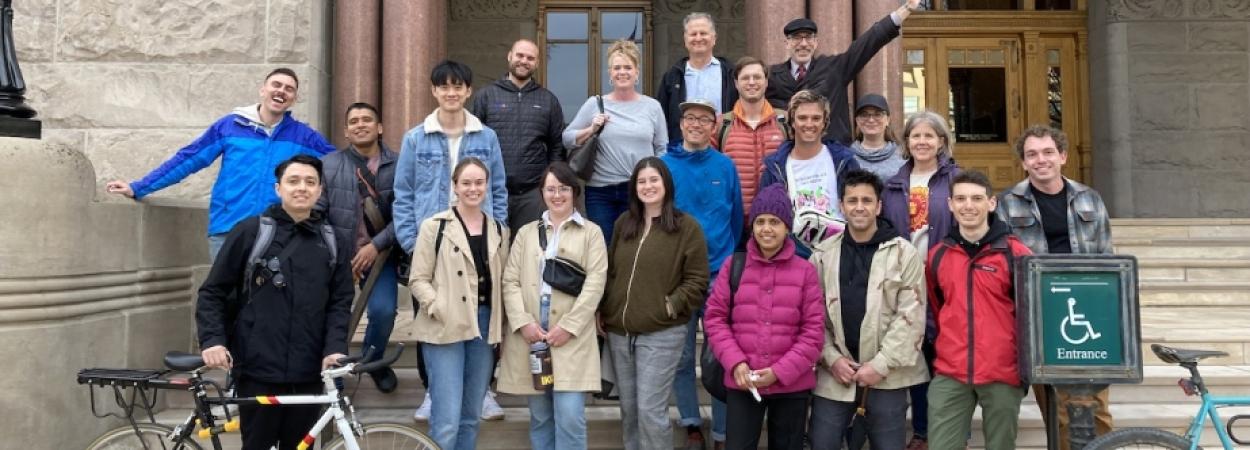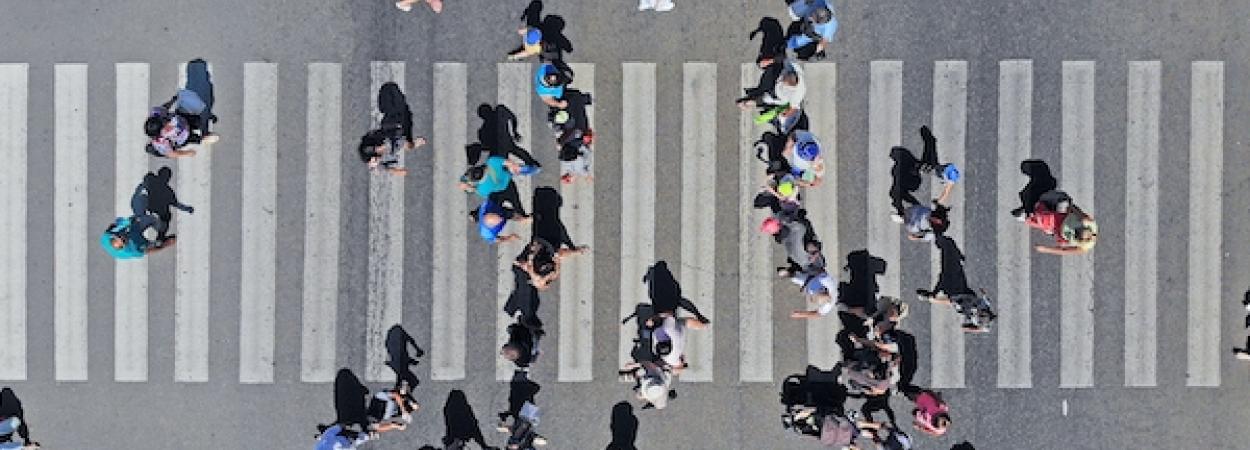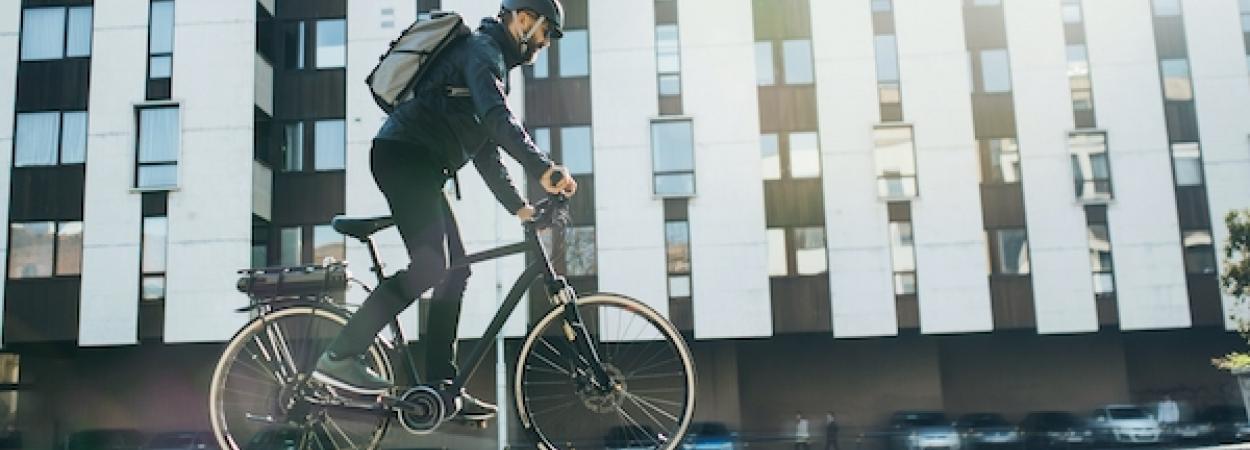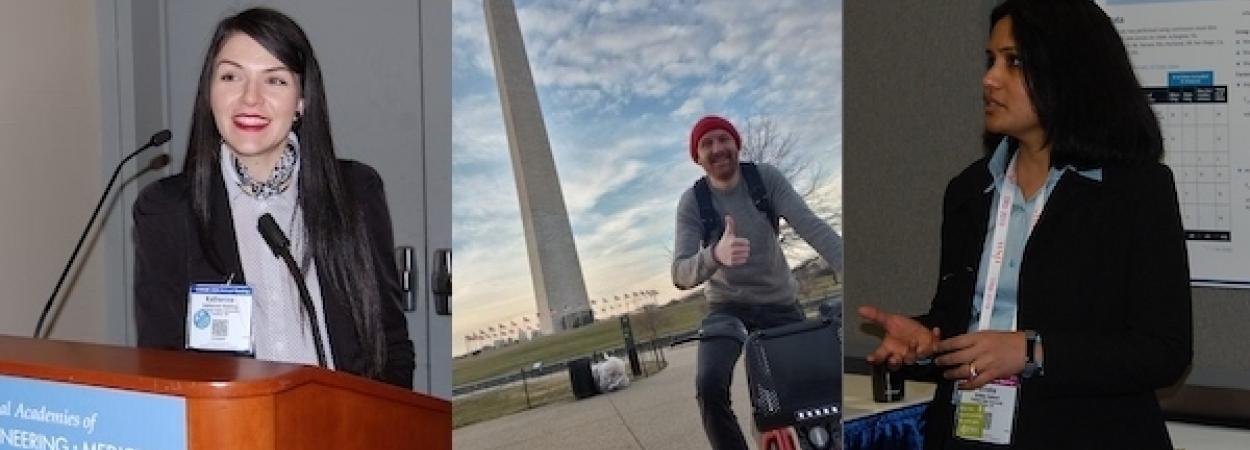Incorporating transportation into the land development process is a big undertaking, with many important angles to be considered. Researchers are translating NITC research on this theme into a popular, easy-to-understand graphic format: comics. Led by an interdisciplinary team at Portland State University and the University of Arizona, they're illustrating transportation considerations in the land development process as a comic to reach a broader audience on this critical topic.
Related: Read about the NITC Research Roadmap on Transportation and Land Use.
Still in development (the images here are early working drafts, illustrated by PSU student Joaquin Golez and Portland, OR illustrator Ryan Alexander-Tanner), the comics are based on research findings from several projects funded by the National Institute for Transportation and Communities (NITC). The project team is working with readers at neighborhood associations and nonprofits to test this unique approach in sharing research findings. We interviewed three of the project team members Kelly Clifton of PSU, Ryan Alexander-Tanner and Susan Kirtley of PSU to hear how it's going.
Can you share more about your body of research on transportation and land use that sparked the idea for this comics project?
Kelly Clifton
I first started thinking about how we can better coordinate land development and transportation when I was doing my dissertation in the late 90s, but I didn't really have an occasion to do any funded research until I came to Portland in 2010. My very first project on this topic was funded by our U.S. DOT-supported program NITC and Metro, our regional body that governs transportation and land. We looked at system development charges because we wanted to know whether the different communities within our region were headed to more auto oriented built environments or not. At the time, Kristi [Currans] was a Masters student at PSU and she did her thesis on this topic. Lucky for me, she stayed on and did her PhD with me. Since then we’ve done five or six projects together, maybe more! Notably we did a big project for CalTrans looking at these questions for affordable housing and impacts on residents. We’ve done a lot of work with the City of Portland, revamping how they're coordinating transportation and land development. More recently, we’ve started looking at how we account for scooters and uber and rideshare and all of these new transportation options.
What unique strengths do project team members bring to this project?
Kelly Clifton
Kristi and I are bringing the technical know-how of transportation and land use, but I’ve always been interested in interdisciplinary projects and combining different talents to tackle a problem. Susan is coming from English and directing PSU’s comic studies program, and Ryan is a local professional comic artist and illustrator. And then we have a Master of Fine Arts student who's going to do a lot of the heavy lifting in terms of the artwork.
Ryan Alexander-Tanner
This is very much in line with my body of work in comics. Earlier in my career, Columbia University hired me to illustrate a book on teaching, and after working closely with the author for over a year I internalized the core message of being a student of your students. I learned how to take in a lot of information and reinterpret it into this accessible medium of comics, and that project helped me create a process for myself. In our informal sessions together I’m repackaging Kelly and Kristi’s expertise combined with Susan’s background as an academic in comics. I enjoy the role of mediating the collaborative process.
Susan Kirtley
As Ryan mentioned, I’m coming at this as a comics scholar. I’ve done research in comics history and I bring with me this interest in visual rhetoric, and I've been very passionate about the potential for comics pedagogy –teaching with and through comics. I feel very strongly that comics have unique potential to inform and educate and entertain, so that's always something that appeals to me. This project is particularly appealing in that I get to learn all kinds of cool stuff, but also think more about that process of how do we teach with comics?
Kelly Clifton
Normally when I'm doing a research project I have an idea, and although we don't know what the outcome is going to be, we do know what the process is going to be. But I’ve never made a comic before, and I don’t know the process. Susan and Ryan offer these checks and balances, and I think everyone's learning something new through this project, which is, I think, really cool.
What do you see as barriers to communicating research?
Kelly Clifton
The first barrier is academic training. We're not really trained on how to talk to a broader audience. We’re very much taught how to talk to each other, to be very cautious in the language we use, and to not over generalize. I’m always very reserved about overstating the implications of work, which is important - but, how can we strike a balance to reach a general audience? Another barrier is retraining my brain. How do you tell a story without all the inherent complexity in research? And how do you adjust based on your audience, which could be academics, decision makers in policy and practice, students, and then the general public? There is no one way to communicate that would hit all those groups.
Susan Kirtley
As academics we are encouraged to talk amongst ourselves, to publish in peer-reviewed scholarly journals in the insular university press world. Not only is it what we’re encouraged to do, it’s also how we’re valued and evaluated in terms of our performance and consideration for tenure. There's a lot of great research that's happening, but it’s not necessarily being shared with a wider audience. How can that form of communication be incentivized to change the norm?
Why do you think it is so important for universities to communicate research findings in new innovative ways like comics?
Ryan Alexander-Tanner
I'm hearing this over and over in my work for universities and in the public health field. They say ‘we're insulated, and we do all this work and nobody reads it, no one engages with it.’ And while I don't think comics are the only method, I do think they're an effective method. We're in this media bombardment era where you're getting slammed with articles, podcasts, talks all the time. It’s hard to break through the noise.
Susan Kirtley
Working with students we talk a lot about going to the source of the information and why that's important, particularly in an era where there's so much misinformation. The expert tells the journalist, and then the journalist tells someone else, and then Buzzfeed picks it up. By the time it gets to that point it's lost the original focus and findings. With Kelly and Kristi, we have the opportunity to tap into the expert source right here and bring it to life with visuals.
Kelly Clifton
Universities really are challenged now, and research in particular, to prove their value to the public. What is the value of a university education, not just to the individual, but to society? A shift to prioritizing communicating your work more broadly is about getting the information out there, but also it’s just showing what we do at universities and how it can have an impact beyond just academia.
What is unique about comics as a medium? What does it have to offer that other mediums do not? Would you agree that comics offer a form of education that suits different learning styles?
Ryan Alexander-Tanner
Yes, absolutely. There is a type of learner that comics are their ideal medium. More important though is distilling your message down to the main idea. Like, what is the point of sharing that message? I don't think the medium is as important as the message itself. But there are many people that wouldn't read a research article, but would read a comic about research. The pairing of text and image is really effective. It can activate multiple parts of your brain. And the concise nature of language in comics lends itself to focusing on the main message. Comics can also break up information into bite-size pieces, and even if you’re stringing them together into something that's long…it just makes it more accessible. Integrating that creative element into something that's academic or factual is powerful. In a way, showing rather than telling is also an economical use of the learner’s time.
Susan Kirtley
I agree with all of that. You can do things with comic art that you can’t do with any other medium. The interplay of text and art together makes it unique, but also particularly well suited to an educational environment. Some folks are visual learners, and comics appeal to them. Comics invites the reader in and makes it interactive. Comics creator Scott McCloud talks about this, between the panels, the reader has to take this really active stance to interpreting and understanding the progression in the gaps between panels. Comics ask us to engage in the story in a way that no other medium does. There are so many unique things about comics that make them particularly well suited for communicating.
Ryan Alexander-Tanner
In the past, a lot of time has been spent trying to validate comics. We’re in a good place now where it’s generally accepted that comics are fun to read and an effective way to communicate. I’ve heard many times things like, ‘You know I had to read 15 books last semester, and your book stood out because it was a comic book and more engaging to read.’
Kelly Clifton
My biggest motivation was to get this out to a completely different audience. If policymakers or transportation students want to read the comic, great! But I really want community and advocacy organizations, the public to be engaged by this format.
What are you hoping to accomplish by communicating transportation land use research through comics? Who is your target audience?
Kelly Clifton
We have two test reader groups that we’ve arranged. One through a Portland neighborhood association and another through Tucson’s Living Streets Alliance who works closely with the Latin community there. And that's exactly who my target audience is: people who are not subject matter experts on transportation and land use, but they experience the impacts on a daily basis. Everybody understands sitting in traffic. Everybody understands getting cut off by someone while you're riding your bike. Everybody understands the challenges of walking on unimproved roads with no sidewalks. But what they might not understand is how do things get this way? More importantly, how do we advocate for change?
What aspect of this project are you most excited about? What do you expect to be most challenging?
Kelly Clifton
What’s most exciting for me is learning new things every time the team gets together. It’s my favorite part of the week! Maybe when the comic is done, it will be anti-climactic because the process itself has been so exciting.
Susan Kirtley
I would agree with you Kelly, I love learning new things, and so this process of translation between research and comics has been so much fun. As a teacher I can’t help but think ‘Ooh this is something I could talk about in class’ or ‘I could do an activity related to what we're doing’.
Ryan Alexander-Tanner
It’s the collaboration for me. We’ve been approaching this as very non hierarchical, and learning a lot from each other. One thing that's very exciting is creating this opportunity for our student artist, Joaquin Golez. A lot of my work as a teacher has been trying to provide opportunities for students interested in comics that I didn't have access to when I was in college. If there had been an opportunity like this, when I was in school, it would have changed my life. Something that is both exciting and challenging is we're going to have to let go and support our student in taking the reins. Seeing their creative interpretation of all the stuff we put together - that's thrilling to me.
Can you share anything about what you’ve developed so far, and any similar initiatives at PSU?
Kelly Clifton
We’ve been in the thick, messy part of it. I’ve just been tossing research findings at them and then they've been grabbing it and throwing it back at me. Sort of playing hot potato, like: what's the structure of this going to look like? How are we going to fit the narrative into that structure? After the comic is published we’ll also do a workshop in the fall at Portland State to talk about this process and the power of comics to communicate research.
Ryan Alexander-Tanner
We are hoping to have a completed comic by the end of summer. We’re making a printed comic book and it's going to consist of three articles which will all be available on the web too.
Susan Kirtley
This project speaks to the potential of Portland State. We have really strong faculty doing interesting research, and we also have the Comic Studies program. Portland has so many amazing local creators like Ryan, so I think this project speaks to this intersection of comics and academics while tapping into the city’s resources as a hub of comics. Moreover, we have amazing students who can create them!
COMICS COMING IN 2022
Want to be notified when the comics are published later this year? Add your email address here!
LEARN MORE ABOUT THE UPCOMING WORKSHOP AT PSU THIS FALL:
USP/WR 407/507 RESEARCH INTO COMICS
Dr. Kacy McKinney and Ryan Alexander-Tanner
Mondays and Wednesdays, 12-1:50pm
Students in this class will explore comics as a deeply engaging medium for communicating complex stories and research findings. Students will learn about comics theory and gain hands-on experience in processes of collaborative research and comics creation. Offering a range of approaches to both research and comics creation, students of the social sciences, arts and humanities, the natural sciences, and professional fields will all gain important skills for communicating research to wide audiences. No prior experience with comics creation or drawing skills necessary.
The National Institute for Transportation and Communities (NITC) is one of seven U.S. Department of Transportation national university transportation centers. NITC is a program of the Transportation Research and Education Center (TREC) at Portland State University. This PSU-led research partnership also includes the Oregon Institute of Technology, University of Arizona, University of Oregon, University of Texas at Arlington and University of Utah. We pursue our theme — improving mobility of people and goods to build strong communities — through research, education and technology transfer.

